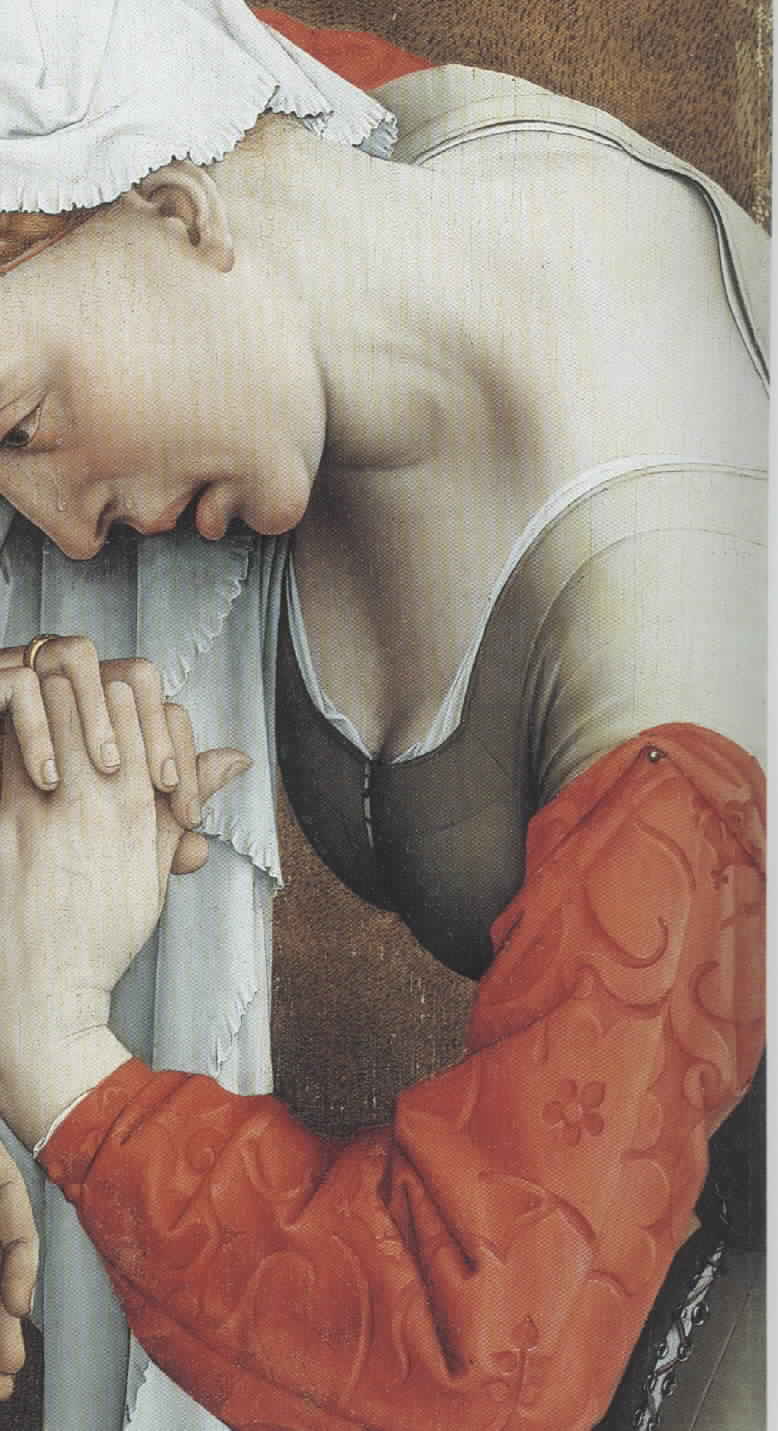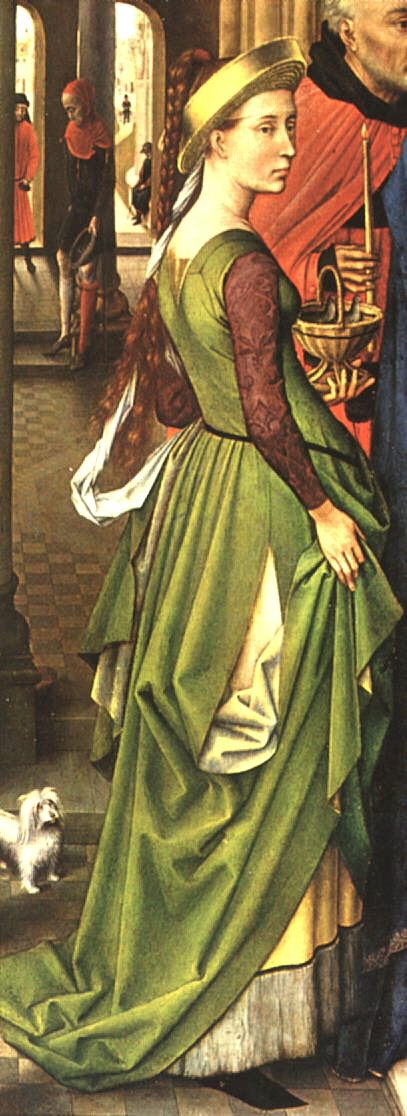I'm getting ready for my next sewing project (other than the blasted hose, which hardly rise to the level of a project IMO, except in the whole finding-help-with-pattern aspect of the thing), which will be a kirtle. So far the plan is to do this in linen, as linen is less expensive than wool, will be comfy at Pennsic, and I have some I am willing to commit to a gown at my current size.
Anyway, I've pretty well decided to go with the waist-seam method of doing this, with trapezoidal skirt panels similar to those shown in the MOL book, as that will be much easier to fit on my self with minimal-to-no outside help. Which brings me to the questions. The bodice. I've been looking at paintings to get the best idea I can of where all the seam lines should be and have run across something strange (to me anyway). In nearly all of the artwork there is a facing or something around the neck that I don't tend to see included on the reproductions of these gowns. You can see it quite clearly here, in a detail from Rogier van der Weyden's Descent from the Cross:
It also looks like there is a small raglan-type seam at the arm. I can't be quite sure if it's just in the facing piece, or if that's actually actually how the sleeve is shaped. It (the raglan-looking seam I mean) would actually make sense if the facing bit was a narrow shoulder strap extending from the back, or cut separately and attached to both front and back, rather like what you see on some later period bodices. In a larger view of the picture, you can see the same angled seam front and back. One thing there clearly is NOT is a seam at the top of the shoulder. Again, this isn't the only place I've seen this sort of seaming in paintings, it seems rather more typical than exceptional, though I've found examples showing a regular shoulder seam as well. (the other thing I really like about this picture is that is appears she's using both eyelets AND lacing rings, with the transition between the two at the waist)
Here's a good back view of this sort of gown, another van der Wyden, this one a detail from "The Presentation at the Temple." Here you can see that the angled seem goes down all the way into the armscye at least:
So, what does all this mean? Is it a sort of raglan sleeve? Or just a separate strap bit? Is the seam around the neck a facing or just a line of stitching or something else? If the strap is separate, I can see where the extra bit around the neck opening would be helpful (it would be helpful regardless really). Should I try this? Or just do the easy seam-over-shoulder bodice?



Dammit, dammit, dammit. Blogger ate my comment. I’ll try again.
ReplyDeleteI did this dress some years ago. Unfortunately, I loaned it to somebody, and I think it was subsequently lost in a messy separation and divorce, so I can’t take pictures, or even remember the exacts of what I did.
That dress fit ok, but there were some issues with support. They may or may not have been related to the raglan sleeve that I was trying. I also used a separate strip in the front. I used to use a curved front seam for my supportive dresses, and I slightly eased that into the straight cut strip on the front. That particular experiment desperately needs to be tried with somebody less bosom-y.
Looking at it all again fresh after several years, it seems to me that the green dress is actually a normally set in sleeve. But I think there’s room for debate on that. Were I to try it again, I’d do the strip over the shoulder, a normal sleeve, but then redesign it as a more square necked kirtle for under my V-neck gown. Of course, it wouldn’t be the same dress.
I’d love to see you take it on and try one of your ideas. I think that many of these ideas can be justified, that is, there is no one right answer, and that I’d like to see the commentary on how doing one of these sleeve possibilities affects the fit and patterning process.
Oh, and just to mess with your head, look at the woman in red in the center panel of the Seven Sacraments Altarpiece. She’s also got the facing, but ALSO a shoulder strap that probably has a seam in top. Many ways to skin a cat, eh? :-D
I'm leaning towards a shoulder strip, rather than an integrated strap, and a set in sleeve at this point too. I can't find anything anywhere to support the idea of them having used an actual raglan sleeve either before or after this period, so I'm thinking the seam line is making the angle because of where the armscye is placed on the front and back of the dress, if that makes any sense? It might be sort of raglan-oid in effect but only because of the shoulder strap thing and where that puts the sleeve head on the body.
ReplyDeleteUsing a facing makes a ton of sense, even if there is a shoulder seam, so the Seven Sacraments dress does not surprise me. I noticed that one is scoop-necked too, so maybe the shape of the neck has something to do with it? The others are more or less square...
Transitional styles of clothing are so much fun to try to figure out.
I know it's been a while since you posted this.. but -I- just read it, so it's new to me.
ReplyDeleteBe careful basing seam placements on the grey Weyden dress. There's some good evidence that the grey dress is made of grey squirrel hides.. so there's a lot of seams between the separate hides.
Sylvie